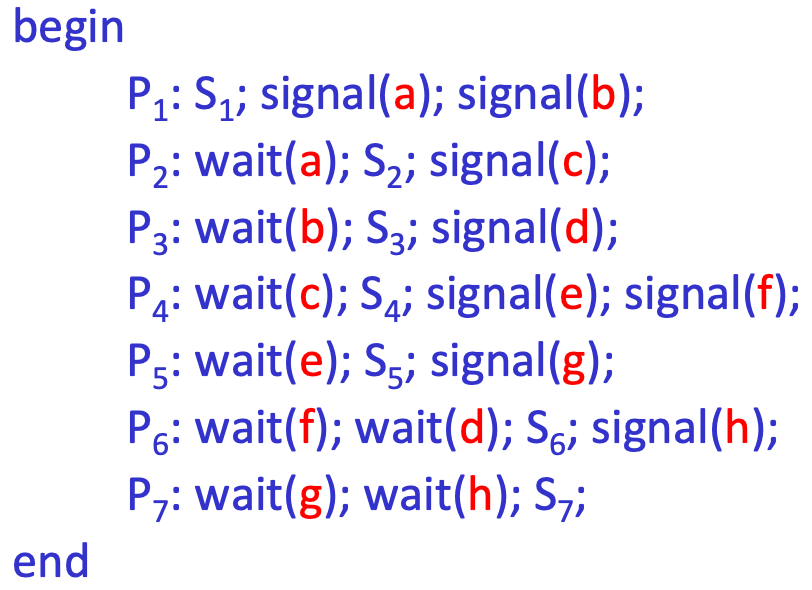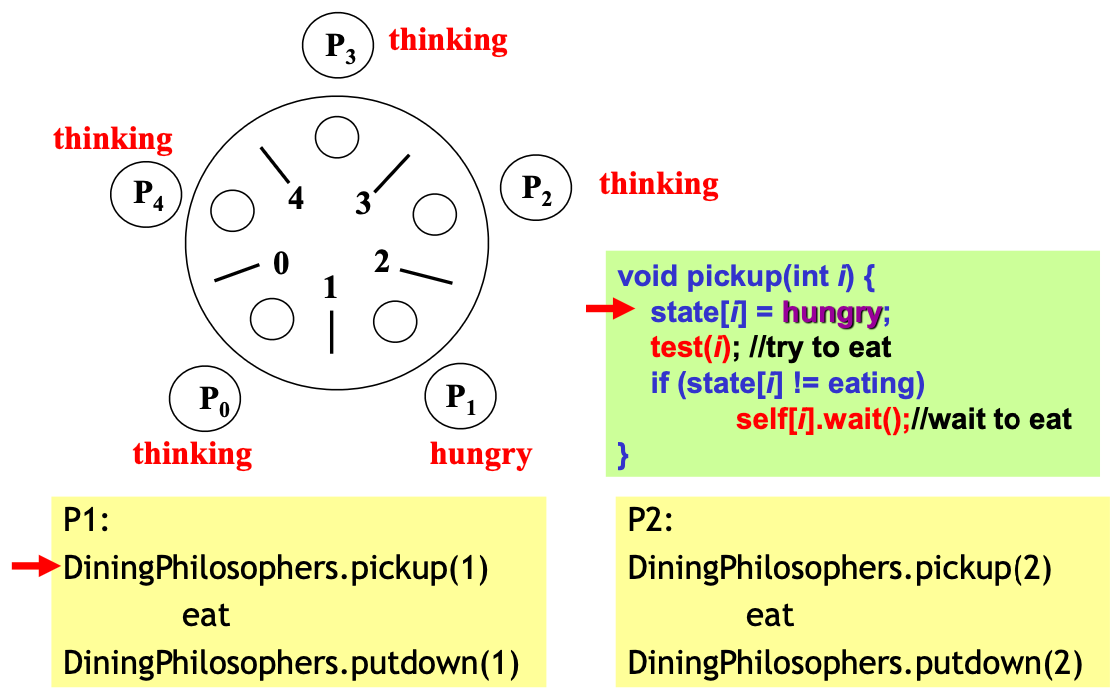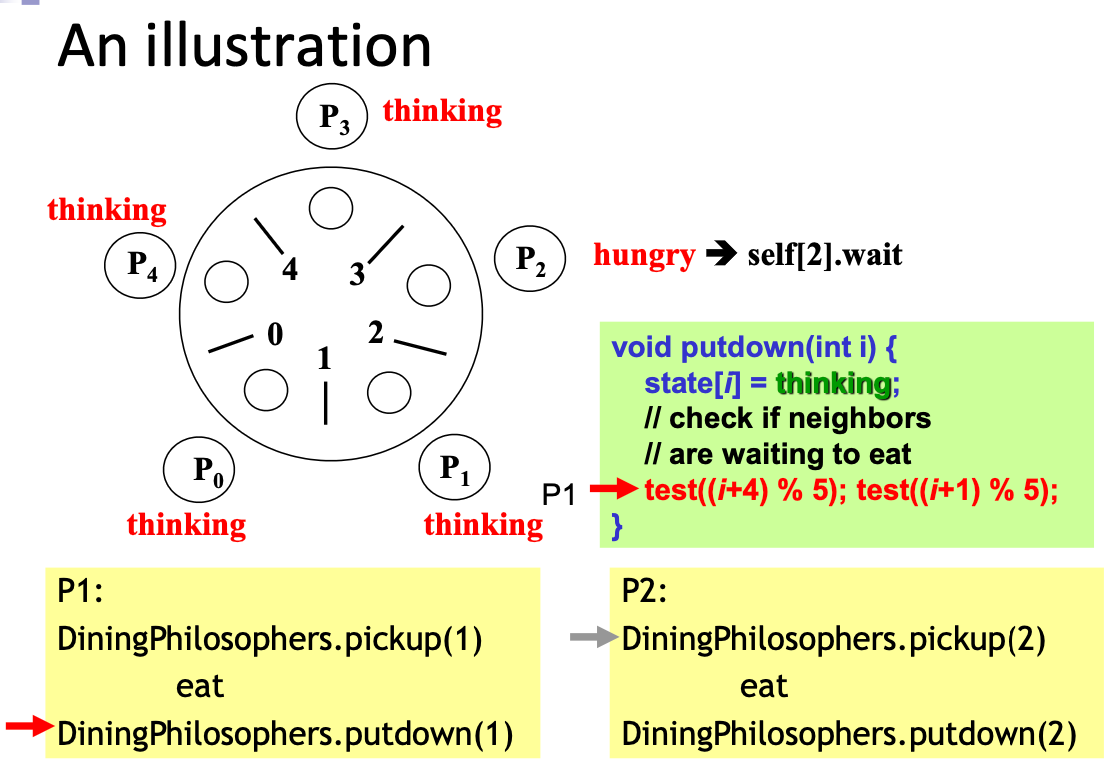[OS] Chapter 6 — Process Synchronization
Background
- 因為有 share 的 data,會被多個 content 去用他,所以需要
- 就算只有一個 core,也會有 Concurrent 的問題(因為會有 content switch)
- 重點就是他們 execute 的 order
- Consumer & Producer Problem
用 counter 去記還有幾個空位
Producer
1
2
3
4
5
6
7while (1) {
nextItem = getItem( );
while (counter == BUFFER_SIZE);
buffer[in] = nextItem;
in = (in + 1) % BUFFER_SIZE;
counter++;
}Consumer
1
2
3
4
5
6while (1) {
while (counter == 0) ;
item = buffer[out];
out = (out + 1) % BUFFER_SIZE;
counter--;
}但是 counter 會是這兩隻 thread 共用的東東,所以會出現不一致的問題:
counter++1
2
3move ax, counter
add ax, 1
move counter, axcounter--1
2
3move bx, counter
sub bx, 1
move counter, bx但是…如果是這樣呢?(counter initially is 5)
1
2
3
4
5
6
7
8
9producer: move ax, counter // ax = 5
producer: add ax, 1 // ax = 6
context switch
consumer: move bx, counter // bx = 5
consumer: sub bx, 1 // bx = 4
context switch
producer: move counter, ax // counter = 6
context switch
consumer: move counter, bx // counter = 4不過如果不是 preemptive 就不會有這個問題了。
Race Condition
- Single processor 的可以用 disable interrupt 或 non-preemptive CPU 來解決。
Critical Section
一個 process 之間溝通的 protocolCritical section: 會產生 race condition 的那段程式碼。
Mutually exclusive: 會有相同 critical section 的 process。他們要在那段 critical section 被迫去 serialize。

Critical Section Requirements
- Mutual Exclusion: if process P is executing in its CS, no other processes can be executing in their CS
- Progress: 有 process 想要進去空的 critical section,就應該要讓他馬上進去。(有效性)
- Bounded Waiting: 不能讓等的人一直等,要 bound 他的 waiting time。(公平性)
- 2 和 3 是可捨取的
Review Slide
- Race condition?
- Critical-Section (CS) problem? 4 sections?
- entry, CS, exit, remainder
- 3 requirements for solutions to CS problems?
- mutual exclusion
- progress
- bounded waiting
Software Solution
Assume only 2 processes, \(P_0\) and \(P_1\)
用
turn決定輪到誰
- 因為是用 single instruction 去 set,所以不會被中斷詠唱
- Requirements
- Mutual Exclusion: Yes
- Progress: Nope,不符合 Progress 的條件, 因為 \(P_0\) 可能已經繞一圈想上去了,但是因為 \(P_1\) 還沒進過 CS,所以他進不去
- Bounded Waiting: Yes,因為是 Round robin.
Peterson’s Solution for Two Processes
跟剛剛那個很像,但是多了一個 flag,用來表示他是不是想要進去 critical section(True 就是他準備好進去了)
對方可以看到別人的 flag,但是只有自己可以改自己的
所以進去的時候就是別人不想進去,或是你拿到 token 了(i.e. 對方沒拿到 token)

Proof
- Mutual exclusion: 用反證
假設他們可以同時在裡面
那下面的條件就要同時存在。

因為他們都在裡面,所以 flag 都是 true
但是 turn 不可能同時是 0 且 1
所以不可能同時進去
- Progress
- 假設 \(P_0\) 想要進去,且 \(P_1\) 不想要進去,要證這時候 \(P_0\) 應該要要可以進去 ⇒ 好像也不用證,反正就可以啊
- 兩個都想進去的時候,那就看
turn,一定有其中一個可以進去
- Bounded Waiting
- 假設當 \(P_1\) 想要進去,但是 \(P_0\) 在裡面。
\(P_0\) 一離開 CS 就把
flag設成 False 了,所以馬上就輪到 \(P_1\) 了\(P_0\) 如果一離開 CS 就又想進去(可能因為剩下的都是 CPU burst,所以就沒有被 content switch 掉)
⇒ 但是因為會在最一開始把 token 給別人,所以會被讓給別人作
Producer/Consumer Problem
如果先進 Consumer 就會 deadlock(i.e. 程式沒有在前進,但是 CPU 在燒)。

正確但是低效能。

正確且優質。

Bakery Algorithm (n processes)
- 像去麵包店
- 在每次進去 CS 前,要抽號碼牌
- 號碼牌最小的先進(因為 counter 是用
++的,所以只能保證是 non-decrease order 的,e.g. 1, 2, 3, 3, 4, 4, 4, 5) - 如果號碼牌一樣,就根據 process ID,小的先
1 | // Process i |
- 最小號碼一定先做 → first come first serve → bounded-waiting time
- 如果沒有 choosing
- 假設目前最大是 5
- P4 抽的比較快,抽到 6,這時候 P1 還是 0
- 然後 P4 會進去 CS(他這時候會以為 P1 沒有要進去,因為他是 0)
- 接下來 P1 抽完了,抽到 6,他就去跟 P4 比,發現跟他一樣,但是他的 pid 比較小,所以他就開開心心的進去了。然後就沒有然後了。(race condition by355)
- 如果有 locking,P4 就會等到 P1 先抽完再跟他比
Synchronization Hardware
只要用到 Hardware 的就算是(包括之前的 disable interrupt)
Atomic instruction
一個 CPU 的 instruction,所以一定會一次做完。
不需要 library 的 support,內建就有了。
TestAndSet()
1 | boolean TestAndSet (bool &lock) { |

Mutual exclusion: Yes
⇒ 因為只有正在 CS 裡面的人把他設成 False 才可以放下一個進去
Progress: Yes
⇒ 只要沒人在裡面,想進去就可以馬上進去
Bounded-Wait: No
⇒ 因為先搶先贏,所以可能一直搶不到
⇒ P0 的 CS 結束了,但是 CPU burst 還沒完,所以他又搶到 lock,然後進去之後 CPU burst 結束了,content switch。換 P1,但是他被擋在外面,CPU burst 燒完之後都輪不到他 QQ,又回到 P0 繼續。
Swap()
把值對調。

- 特性也跟剛剛一樣
Review Slide (2)
- Use software solution to solve CS?
- Peterson’s and Bakery algorithms
- Use HW support to solve CS?
TestAndSet(),Swap()
Semaphores
- Resource counting 的問題。
- 一個值 indicate 想要透過 semaphore 保護的資源的數量多寡。
- If #record = 1 → binary semaphore, mutex lock
- if #record > 1 → counting semaphore
- 用兩個 atomic operation:
wait:搶資源1
2
3wait(S) {
while (S <= 0); // busy waiting
}用的是 Spinlock → 等待還是會燒 CPU(因為一直在作指令)
signal:放資源1
2
3signal(S) {
S++;
}
POSIX Semaphore
他是 OS 的 API
Semaphore is part of POSIX standard BUT it is not belonged to Pthread
- It can be used with or without thread
因為 lock 多是在 threads 之間,semaphore 多是在 process 之間。
POSIX Semaphore routines:
1
2
3
4
5sem_init(sem_t *sem, int pshared, unsigned int value)
sem_wait(sem_t *sem)
sem_post(sem_t *sem)
sem_getvalue(sem_t *sem, int *valptr) // check
sem_destroy(sem_t *sem)Example:
1
2
3
4
5
6
7
sem_t sem;
sem_init(&sem);
sem_wait(&sem);
// critical section
sem_post(&sem);
sem_destroy(&sem);Another example
1
2
3
4
5
6do {
wait(mutex); // pthread_mutex_lock(&mutex)
// critical section
signal(mutex); // pthread_mutex_unlock(&mutex)
// remainder section
} while(1);- Progress: Yes
- Bounded waiting: 取決於
wait的實作
Non-busy waiting Implementation
Semaphore is data struct with a queue (可以用各種 queue strategy)
1
2
3
4
5typedef struct {
int value; // init to 0
struct process *L;
// “PCB” queue
} semaphore;
wait()andsignal()- 需要用到
block()andwakeup()兩個 system calls。(明顯的缺點,需要多用到 system call)
1
2
3
4
5
6
7void signal(semaphore S) {
S.value++;
if (S.value <= 0) { // 注意有 `=`,因為我們先 `++` 了
remove a process P from S.L;
wakeup(P);
}
}1
2
3
4
5
6
7void wait(semaphore S) {
S.value--; // subtract first
if (S.value < 0) { // 注意沒有 `=`
add this process to S.L; // 要先放進去才能去睡覺
block();
}
}- 需要用到
更多行加上更多 share data(那些 queue),所以要確保他有 atomic 的特性。可以用:
- Single-processor: disable interrupts
- Multi-processor:
- HW support (e.g. Test-And-Set, Swap)
- SW solution (Peterson’s solution, Bakery algorithm)

如果等待時間短,不如用 busy waiting,不然要一直 call system call。
Cooperation Synchronization
因為會有資料的 independency,所以也可以用這個來解。
Example:
P1 executes S1; P2 executes S2 (S2 be executed only after S1 has completed)
sync一開始設成 0
A More Complicated Example (DAG)

- (Initially, all semaphores are 0)

Deadlocks & Starvation
- Deadlocks: 2 processes are waiting indefinitely for each other to release resources(程式之間彼此互卡)
- Starvation:
- example: LIFO (Last In First Out) queue in semaphore process queue
- 有人可以執行只是輪不到我
Review Slide (3)
- What’s semaphore? 2 operations?
- What’s busy-waiting (Spinlock) semaphore?
- What’s non-busy-waiting (Non-Spinlock) semaphore?
- How to ensure atomic wait & signal ops?
- Deadlock? starvation?
Classical Problems of Synchronization
解決方法很多,重點是去定義問題。
- Bounded-Buffer (Producer-Consumer) Problem
- Reader-Writers Problem
- Dining-Philosopher Problem
Bounded-Buffer Problem
就上面那些問題。
- A pool of n buffers, each capable of holding one item
- Producer:
- grab an empty buffer
- place an item into the buffer
- waits if no empty buffer is available
- Consumer:
- grab a buffer and retracts the item
- place the buffer back to the free pool
- waits if all buffers are empty
Readers-Writers Problem
- reader processes → 只會讀
- writer processes → 只會寫
- 如果都是 reader 那沒差,反正同時 read 也不會出事。但是 writer 就只能一個人寫,連 reader 都不能同時 read。(Exclusive access)
- Different variations involving priority
First RW problem: no reader will be kept waiting unless a writer is updating a shared object (只要符合上面的基本定義就好了)
Second RW problem: first 的條件加上 writer 不能 starvation。
→ Writer 要比較高的 priority
→ once a writer is ready, no new reader may start reading
First Reader-Writer Algorithm
1 | // mutual exclusion for write |
1 | Writer() { |
1 | Reader() { |
Writer 會有 starvation,因為 reader 共用一個 lock,所以可以一直輪流佔著
⇒ Second RW problem solve it.
Dining-Philosophers Problem

- 每個人左邊跟右邊都有一根筷子(五個人五隻筷子)
- 吃飯需要兩隻筷子
- 一隻筷子只能一個人拿
- 吃完就要把筷子放下
- Deadlock problem
- 每個人拿左邊的筷子直到吃完飯 → 卡死
- Starvation problem
- 不能讓人一直拿,一直吃
Monitors
目的是要更抽象化(他是在 language level)
跟 OO 很像
像是由一個 class 定義的東西:有自己的 methods、variables、private variables。
(Private variables 只能由自己的 methods 操作)
和 OO 不同的是他會確保他的 process 只會有一個在 active (running) 的狀態
Schematic View ****

- Shared data → private variable
- Operations → methods
- Initialization code → constructor
- Entry queue → 想要用 monitors 的傢伙
(Monitor) Condition Variables
他是一個獨立的同步化 tool,跟 monitor 沒關係
Event driven
To allow a process to wait within the monitor, a condition variable must be declared, as
condition x, y;Can be used with
wait()andsignal()(但是跟上面的那些毫無關係,請不要搞混,定義完全不同)x.wait()有一個 event queue,所以這像是 enqueue。(上面的那個是 counting)
x.signal()像是 dequeue,把裡面的 process 叫醒去工作。如果裡面沒有東西,就啥都不會發生。(如果是 semaphore,值會繼續加上去)

Dining Philosophers Example
- Thinking — 根本沒要吃
- 假設大家都是看得到彼此的狀態的(i.e. 有 Global information)
1
2
3
4
5
6
7
8
9
10
11monitor dp {
enum {thinking, hungry, eating} state[5]; // current state
condition self[5]; // delay eating if can’t obtain chopsticks
void pickup (int i) // pickup chopsticks
void putdown (int i) // putdown chopsticks
void test (int i) // try to eat
void init() {
for (int i = 0; i < 5; i++)
state[i] = thinking;
}
}1
2
3
4
5
6void pickup(int i) {
state[i] = hungry;
test(i); // try to eat (to prevent deadlock)
if (state[i] != eating) // 沒成功吃到
self[i].wait(); // wait to eat
}1
2
3
4
5
6
7
8void putdown(int i) {
state[i] = thinking;
// check if neighbors are waiting to eat
// 叫他們起來吃飯
test((i+4) % 5);
test((i+1) % 5);
}1
2
3
4
5
6
7
8
9
10
11
12void test(int i) {
if ((state[(i + 4) % 5] != eating)
&& (state[(i + 1) % 5] != eating) // 左邊和右邊有沒有在吃
&& (state[i] == hungry)) { // 和我想不想吃
// No neighbors are eating and Pi is hungry
state[i] = eating;
// 把他自己叫起(如果是 pickup call 的,這是沒有用的
// 但是如果是 putdown call 的,那就會搖醒睡著的)
self[i].signal();
}
}An illustration







Thread Programming
(考試比較不會考)
Pthread Lock/Mutex Routines
To use mutex:
- Declared as of type
pthread_mutex_t - Initialized with
pthread_mutex_init() - Destroyed with
pthread_mutex_destroy() - Use
pthread_mutex_lock()andpthread_mutex_unlock()
1 |
|
Condition Variables (CV)
跟上面的一樣。
In Pthread, CV type is a
pthread_cond_t- Use
pthread_cond_init()****to initialize pthread_cond_wait (&theCV, &somelock)pthread_cond_signal (&theCV)pthread_cond_broadcast (&theCV)→ 把 queue 裡面全部的 thread 都叫醒(i.e. 對他們全部作signal)
- Use
Example
- 一個 thread 在 x = 0 的時候做事
- 另一個負責 x--

一定要把 wait 和 signal 在 mutex 被 lock 的時候才能用(不然連 code 都不會跑)
- 因為 call wait 和 signal 的時候,大多會和其他 conditional variable
有相依性(In this case:
x),所以 lock 起來才是合理的。 - 要確保
cond不會有 concurrent write 的問題。
⇒ 所以至少要包到他本身和他的觸發條件。
- 因為 call wait 和 signal 的時候,大多會和其他 conditional variable
有相依性(In this case:
What really happens...
action: Lockmutex
actioncallwait, put thread into sleep and release the lock. ⇒ 因為wait會直接 releasemutex(所以不是下面那行做的,是wait就直接 release 掉了!)counterlockmutex
countergo into CS and callsignal.actionis waked up, but thread is locked. (unlock會先呼叫lock確定可以跑,但顯然不行,因為 lock 還在 counter 那邊 )
countercall unlock.actionRe-acquire lock and resume execution
actionrelease lock
- 另一個我們之所以要用 lock 包住的原因。
ThreadPool Implementation
Task structure

- 存 function pointer 跟 argument
ThreadPool structure

thread_count— 紀錄一共有多少 threads*thread— threadPoolhead—*queue的 headtail—*queue的 tailshutdown— threadPool 是不是要結束掉了(決定要不要 break while loop)
Allocate thread and task queue

Implement


Synchronized Tools in JAVA
Synchronized Methods (Monitor)
1
2
3
4
5
6public class SynchronizedCounter {
private int c = 0;
public synchronized void increment() { c++; }
public synchronized void decrement() { c--; }
public synchronized int value() { return c; }
}加上 synchronized 就可以保證只有一個才操作。所以可以看到有動到
c的都有加。如果沒有動到 share data 的,可以不用加,增加平行度。Synchronized Statement (Mutex Lock)
1
2
3
4
5
6
7
8public void run()
{
synchronized(p1)
{
int i = 10; // statement without locking requirement
p1.display(s1);
}
}
Review Slides (4)
- Bounded-buffer problem?
- Reader-Writer problem?
- Dining Philosopher problem?
- What is monitor and why need monitor?
Atomic Transactions
(考試不太會提)
- System Model
- Transaction: 一系列的 operation
- Atomic Transaction: 需要一次完成 transaction,all or nothing
- DB 很容易需要
- File I/O Example
- Transaction 是一連串的 read and write
- 像是 version control 的工具,需要有 commit (成功)、abort(失敗)、rolled back(失敗後要 undo)
- 所以重點是要有 log
- 因為有 log 才能回推重建
- 也叫做 checkpoint
- 存在 secondary storage
- 也會有 checkpoints
- 還原點,上一個 commit 的點
- 說不定會直接不 undo,然後 apply checkpoint
Review Slides (5)
- What is atomic transaction?
- Purpose of commit, abort, rolled-back?
- How to use log and checkpoints?
Textbook Problem Set


此筆記為清華大學周志遠教授作業系統之課堂筆記,所有內容及圖片皆取材於課堂內容。
如內容有誤,歡迎來信 mail@arui.dev。